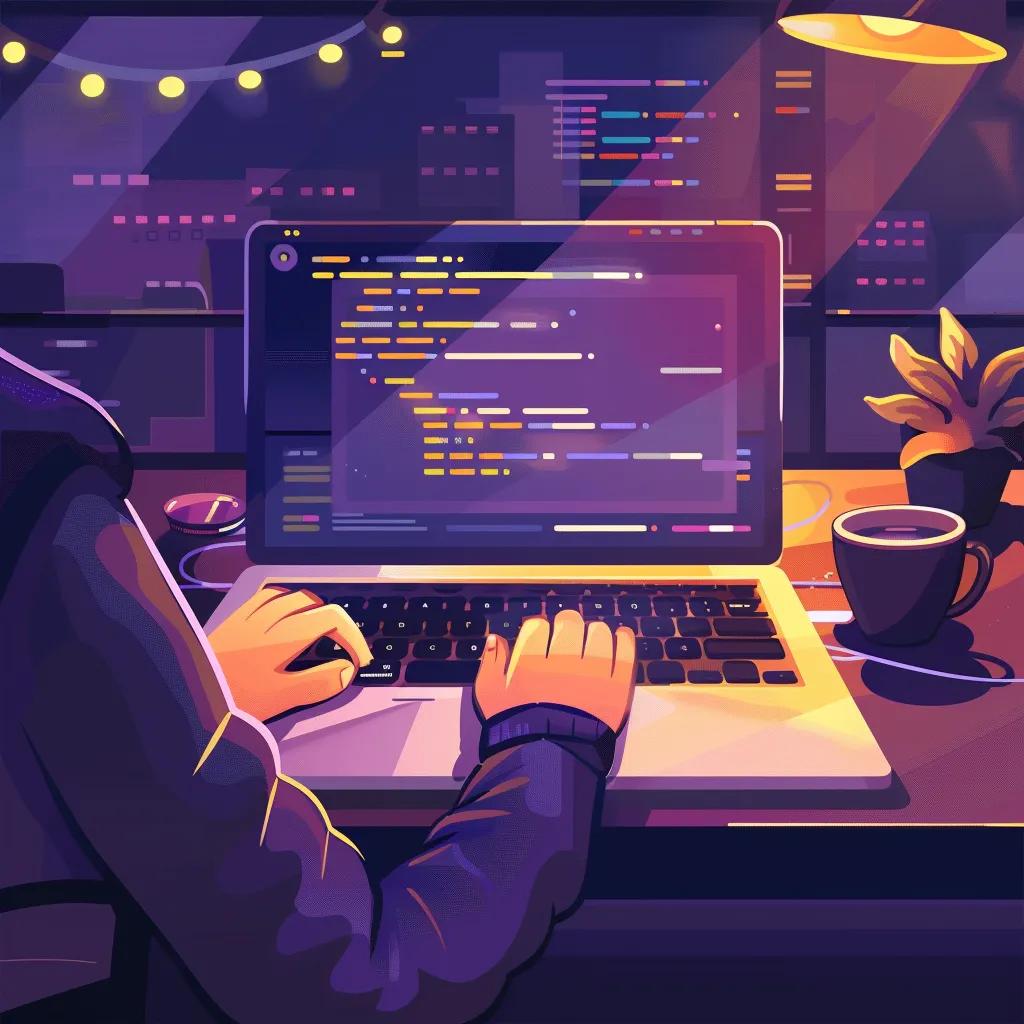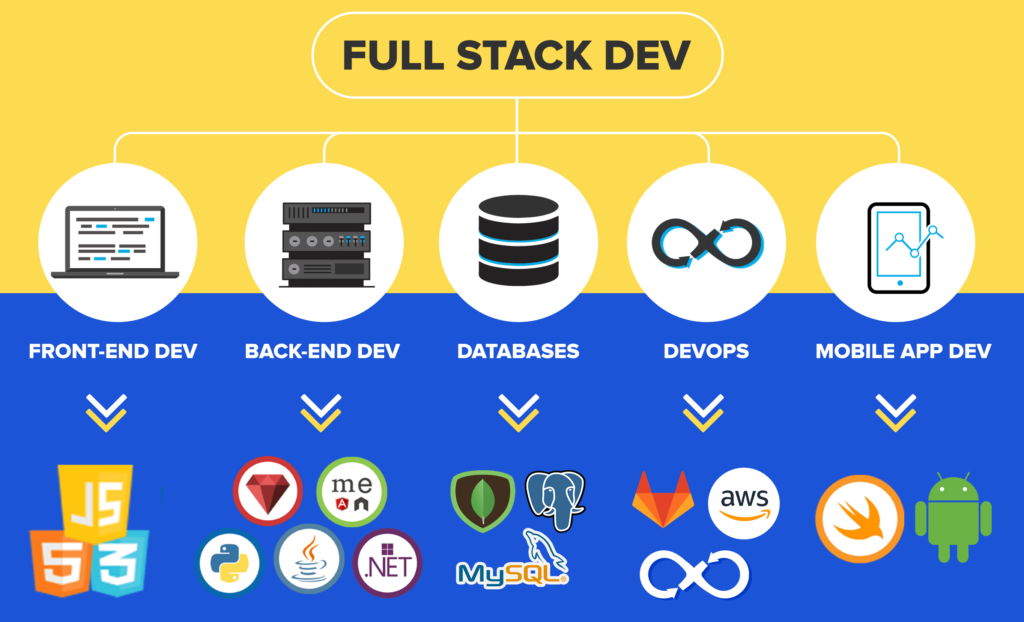What Is a Full Stack Developer and Why Enroll in a Full Stack Developer Course?
A Full Stack Developer builds both the client-side and server-side of web applications, bridging user interfaces and database logic. Understanding this role’s scope and the course’s career impact sets the foundation for specialized skill development.
What Does a Full Stack Developer Do?
A Full Stack Developer designs user interfaces with HTML, CSS, and JavaScript while implementing server-side features using languages like Python or Node.js. They write APIs, integrate databases, and deploy applications to cloud platforms. By orchestrating front-end and back-end code, they deliver cohesive web solutions that meet user and business requirements.
This end-to-end responsibility ensures that applications not only look polished but also perform reliably under real-world conditions, leading us to why full stack proficiency is vital in tech today.
Why Is Full Stack Development Important in Today’s Tech Industry?
Full Stack Development accelerates product delivery by empowering one professional to handle multiple layers of an application. Companies value this versatility because a developer who “owns” both front and back end helps reduce team bottlenecks and maintenance overhead. As web architectures grow more complex, full stack skills translate directly into faster feature iteration and cost-efficient staffing.
This industry demand links directly to the advantages you’ll gain from a structured Full Stack Developer Course.
How Does a Full Stack Developer Course Prepare You for the Job Market?
A Full Stack Developer Course provides hands-on learning, expert guidance, and real-world projects that mirror workplace scenarios. You’ll learn version control, collaborative workflows, and deployment practices used by top tech companies. By building a portfolio of live applications, you demonstrate practical competence that employers seek, shortening your job search and boosting interview confidence.
Mastering these comprehensive skills naturally leads us to explore the core technologies and languages covered in such a course.
Which Core Technologies and Programming Languages Will You Learn in a Full Stack Developer Course?
A balanced course covers front-end, back-end, database, and deployment tools to ensure you can build and ship full web applications independently.
How Does Python Fit into Full Stack Development?

Python serves as a powerful back-end language thanks to its readability, extensive libraries, and robust frameworks. It simplifies server logic, data manipulation, and API creation. Full Stack Developer Course teaches Python fundamentals—variables, functions, object-oriented programming—and applies them within Django or Flask to build secure, scalable back-end services.
With Python mastering server tasks clarified, the next focus is on front-end technologies that deliver user experiences.
What Front-End Technologies Are Covered?
The course introduces:
- HTML5 for structuring web pages
- CSS3 and frameworks like Bootstrap for styling
- JavaScript ES6+ for interactivity
- Front-end libraries and frameworks (React, Angular, Vue.js) for component-based UI
These technologies combine to create responsive interfaces that engage users. After establishing the user interface foundation, you’ll explore server frameworks that power application logic.
Which Back-End Frameworks and Tools Will You Master?
Below is an overview of back-end frameworks included:
| Framework | Type | Purpose |
|---|---|---|
| Django | Full-stack | Rapid back-end development, admin UI |
| Flask | Microframework | Lightweight APIs and microservices |
| Node.js | Runtime | JavaScript server-side applications |
| Express.js | Web framework | Minimalist routing and middleware |
These frameworks enable you to implement RESTful APIs, authentication, and business logic. Mastery of these tools ensures you can select the right solution for diverse project requirements.
Building on frameworks, the course also covers data storage and API design.
How Are Databases and API Development Included?
Full Stack Developer Course teaches relational databases (SQL: PostgreSQL, MySQL) and NoSQL options (MongoDB). You learn to model data schemas, write efficient queries, and use ORMs like SQLAlchemy and Django ORM. API development modules cover RESTful design, GraphQL basics, and secure authentication strategies. By integrating database operations with API endpoints, you create end-to-end data flows for modern web applications.
With technologies in view, let’s examine the typical curriculum structure that sequences these topics for effective learning.
What Is the Typical Curriculum Structure of a Full Stack Developer Course?
A structured curriculum guides you from foundational concepts to advanced application and deployment techniques.
What Are the Key Modules from Fundamentals to Advanced Topics?
A Full Stack Developer Course typically includes:
- Module 1: Programming Fundamentals – Variables, control flow, data structures
- Module 2: Front-End Development – HTML, CSS, JavaScript, responsive design
- Module 3: Back-End Development – Python basics, Django, Flask, Node.js
- Module 4: Database Management – SQL, NoSQL, ORM integration
- Module 5: API Design – RESTful services, GraphQL
- Module 6: DevOps & Deployment – Git, Docker, Kubernetes, AWS
How Is Version Control and Deployment Taught?
Version control lessons introduce Git and GitHub workflows, branching strategies, and merge practices. Deployment training covers containerization with Docker, orchestration via Kubernetes, and hosting on AWS, Azure, or DigitalOcean. You will automate build and deploy pipelines using CI/CD principles so applications roll out reliably to production environments.
After mastering deployment, the curriculum transitions to project labs that cement your expertise.
What Hands-On Projects Will You Build?

You’ll construct real applications that demonstrate full stack proficiency:
- Blog Platform – CRUD operations with user authentication
- Task Manager – REST API and dynamic front-end interface
- E-commerce Store – Shopping cart, payment integration, admin panel
These projects become portfolio highlights that showcase both your technical and problem-solving abilities.
How Can You Build a Strong Portfolio with Full Stack Developer Projects?
A portfolio presents your technical journey and confirms readiness to potential employers.
What Beginner Projects Are Ideal for New Learners?
- A to-do list app using Python Flask and vanilla JavaScript
- A static landing page built with HTML and CSS
- A calculator coded in JavaScript
These projects establish foundational skills and prepare you for intermediate challenges.
Which Intermediate Projects Showcase Practical Skills?
- E-commerce mockup with shopping cart and user profiles
- Social media feed implementing CRUD operations and real-time updates
- Data visualization dashboard powered by React and Chart.js
By integrating multiple technologies, these projects highlight your adaptability and design sense.
What Advanced Projects Demonstrate Expertise?
- Real-time chat app with WebSockets and Redis
- AI integration using Python machine learning libraries
- Microservices architecture deployed on Kubernetes
Completing these complex builds underscores your capacity to tackle large-scale systems and innovative solutions.
Next, we’ll examine the specific skills and competencies you’ll acquire throughout this course.
What Skills and Competencies Will You Gain from a Full Stack Developer Course?
A Full Stack Developer Course equips you with a blend of technical and soft skills essential for full lifecycle development.
Which Technical Skills Are Essential for Full Stack Developers?
- Front-end: HTML5, CSS3, JavaScript ES6+, React/Angular/Vue
- Back-end: Python, Django, Flask, Node.js, Express.js
- Databases: SQL (PostgreSQL, MySQL), NoSQL (MongoDB)
- DevOps: Git, Docker, Kubernetes, AWS/Azure
Mastering these areas enables you to architect, build, and maintain complete web applications.
How Do Problem Solving and UI/UX Design Fit into Full Stack Development?
Effective Full Stack Developers apply design principles—accessibility, responsive layouts, intuitive interfaces—and solve user-centric challenges. By combining analytical debugging with empathy for user experience, you ensure applications are both robust and delightful to use. This dual capability sets you apart in cross-functional teams.
Why Is Version Control and Testing Important?
Version control with Git tracks changes, supports collaboration, and enables rollback when issues arise. Testing practices—unit tests, integration tests, end-to-end tests—ensure code correctness and prevent regressions. Together, these competencies maintain application stability as you iterate on features and refine performance.
What Are the Career Opportunities and Salary Expectations After Completing a Full Stack Developer Course?
Graduates can pursue diverse roles, with salaries influenced by experience, location, and specialization.
How Do Full Stack Developer Salaries Vary by Experience and Location?
| Experience Level | Average Salary (USD) | Major Locations |
|---|---|---|
| Entry-level | $65,000 – $85,000 | Austin, Atlanta, Denver |
| Mid-level | $90,000 – $120,000 | New York, Seattle, Boston |
| Senior | $130,000 – $160,000 | San Francisco, NYC Metro |
Full Stack Developer Salary Ranges
Full stack developer salaries vary based on experience and location, with entry-level positions typically earning between $65,000 and $85,000 USD, mid-level roles ranging from $90,000 to $120,000 USD, and senior developers potentially earning $130,000 to $160,000 USD [1]. These figures reflect market demand and regional cost of living, with higher salaries often found in major tech hubs.
Robert Half Technology, 2024 Salary Guide (2024)
This salary information supports the article's claims about the financial prospects of a full stack developer career.
Salaries reflect market demand and regional cost of living, with additional premium for full stack versatility.
What Job Roles Can You Pursue as a Full Stack Developer?
- Full Stack Engineer – End-to-end application ownership
- Web Developer – Focused front-end and back-end integration
- Software Engineer – Broader software lifecycle contributions
- DevOps Engineer – Release automation and infrastructure as code
Role names vary, but core responsibilities center on delivering and maintaining web systems.
How Can You Prepare for Full Stack Developer Interviews?
- Study data structures and algorithms to handle coding challenges.
- Practice system design questions to discuss architecture decisions.
- Review JavaScript and Python fundamentals with code snippets.
- Build and present portfolio projects as case studies.
- Mock interviews using coding platforms and peer feedback.
This structured preparation boosts both technical mastery and interview confidence.
Who Should Enroll in a Full Stack Developer Course and How Long Does It Take to Become Job-Ready?
A Full Stack Developer Course accommodates diverse backgrounds and optimizes time to employment.
Is This Course Suitable for Beginners, Career Changers, or Experienced Developers?
- Beginners gain programming fundamentals and step-by-step guidance.
- Career changers build a coherent skill set that aligns with industry needs.
- Experienced developers fill skill gaps and advance to full stack roles.
The curriculum adapts to varying skill levels, ensuring everyone achieves market readiness.
What Is the Typical Duration of a Full Stack Developer Course?
Most comprehensive programs span 12–24 weeks part-time or 8–12 weeks full-time. This timeframe balances deep learning with practical project work to ensure you can confidently apply skills in real-world scenarios.
How Can Continuous Learning Enhance Your Full Stack Career?
Ongoing education—exploring emerging frameworks, staying current with DevOps tools, and contributing to open-source projects—sustains your competitiveness. Regularly updating your portfolio and certifications signals to employers your commitment to excellence and adaptability.
Enrolling in a Full Stack Developer Course now positions you at the forefront of web development, combining Python mastery with full stack versatility. Through a carefully structured curriculum, hands-on projects, and continuous learning strategies, you’ll build the skills and portfolio employers demand. By mapping your progress from fundamental concepts to advanced deployments, you can transition smoothly into rewarding roles and negotiate competitive salaries. Start your journey today and transform your passion for coding into a thriving full stack career.
Conclusion
Enrolling in a Full Stack Developer Course equips you with in-demand skills that bridge both front-end and back-end development, enhancing your employability in a competitive job market. By mastering technologies like Python, HTML, and JavaScript, you’ll be well-prepared to tackle real-world projects and build a standout portfolio. This comprehensive training not only boosts your technical expertise but also positions you for lucrative career opportunities. Take the first step towards your future in web development by exploring our course offerings today.


